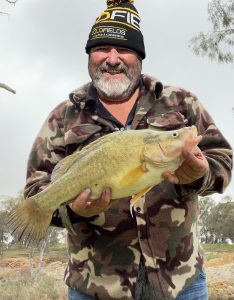
Kevin Wild of the Maryborough Angling Club with one of the yellowbelly he caught from the Loddon River below Laanecoorie Weir (Picture: Don Rayner).
Freshwater
Kevin Wild of the Maryborough Angling Club reports that Tullaroop, Cairn Curran and Laanecoorie Reservoirs are now completely full, and – with water running over their respective weirs – closed to boating.
However, some nice fish have been caught from the banks of those waters, and his visit to the Loddon River below Laanecoorie Weir with Don and Robert Rayner produced several good size yellowbelly.
From all accounts the inclement weather had put most anglers off fishing the Crater Lakes at Camperdown, but Roger Tolland ventured out onto Lake Bullen Merri last week where he caught a mixed bag of fish while trolling lures that included a 2.5 kg chinook salmon.
Corio Bay/Bellarine Peninsula
While we are accustomed to seeing an influx of large female southern calamari in spawning mode off Queenscliff and within Port Phillip Heads, particularly at this time of year, it’s rare to encounter them in Corio Bay.
However, Garry Ridgeway caught several well over the kilogram mark off Clifton Springs last Tuesday prior to trying for whiting.
Initially, the whiting he caught were small, some undersize, but come evening, he caught six really good size specimens. However, as sometimes happens, the bite shut down on high slack water, and that was his lot.
Making a daybreak start on Thursday morning, Andrew Johnson and Pete Dawson anchored up in fairly calm conditions off Leopold in pursuit of whiting but found nothing doing there.
They moved several times, but initially at least, they only caught small fish, and there was an abundance of those.
Eventually, over one of their historically good marks off Curlewis, they finished up with a bag limit catch of keepers before heading back to the ramp, and it was here an associate arrived with two really good size snapper, the first I’d heard of being caught this spring.
And, speaking of snapper, Simon Werner – after collecting a fresh cuttlefish floating on the surface – minus its head, while crewing aboard Adamas Charters. And, it was really fresh, so he wasn’t about to let that go to waste.
So, with ideal conditions on Sunday, with a north westerly wind, he set out on the Portarlington breakwater with snapper in mind.
Nothing happened immediately, but at around 4.00 pm caught one of 3 kg and pulled the hooks on two more after that.
Vale Ross Middleton
Sadly, my fishing companion as a teenager, Ross Middleton, who later went on to succeed in a variety of fishing challenges that included land-based game fishing at Green Cape in southern NSW, passed away last week.
Initially, we fished from Yarra Street and Cunningham piers where we caught the usual variety of species, but – from 1961 – following reports of large snapper being caught from the Geelong Grammar School Lagoon in winter, they – above all else – became our obsession for a number of years.
In any event, Ross’ passing ends an era, during which he became something of a fishing legend and whose name still regularly surfaces in serious piscatorial discourse.
Tony asks:
Geoff, what’s the difference is between a pike and a snook, and can they be caught locally?
Tony, snook are also known as pike, to which they were referred before being officially called snook, but just to confuse matters, in southern Australia, there are two species referred to as pike.
Of most interest to anglers is the short-finned pike, now officially known as snook. These commonly exceed 80 cm in length, often reach weights in excess of 3 kg, and are commonly found over inshore seagrass beds.
From a boat, the traditional implement of capture is a monofilament handline of say 15 kg breaking strain, leaded at intervals with small barrel sinkers and baited with a pilchard or garfish on a flight of ganged hooks.
We’ve also caught them land based on bibbed lures, from the North Shore rocks – and at this very time of year – when the tide fell low enough to provide access with dawn and dusk being the best times to fish for them.
